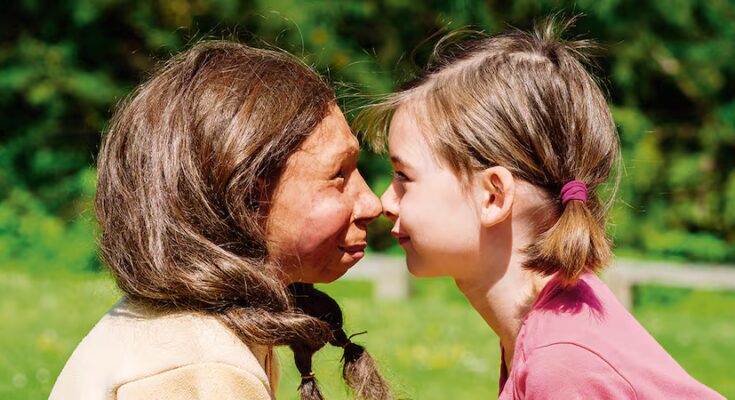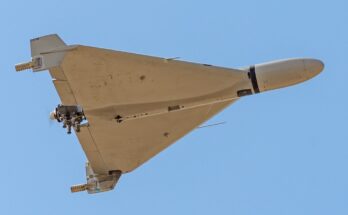Kissing is a great evolutionary mystery. This act of locking lips with another individual does not appear to have any advantage in the reproduction or survival of the species, and can cause problems, such as the transmission of diseases. However, the vast majority of humans (and many other animal species) enjoy doing it immensely, to the point that kissing has inspired poems, songs, paintings or films for centuries. Now, a study from the University of Oxford dates the beginning of this gesture which can express love, desire, affection or reconciliation: researchers believe it is around 21 million years old. The study found that this behavior evolved in the common ancestor of humans and other great apes, and that Neanderthals kissed, with a probability close to 84%. The results, published this Wednesday in the journal Evolution and human behaviorreveal that, far from being a recent human cultural invention, kissing is an ancient trait deeply rooted in our biology.
“This is the first time anyone has taken a broad evolutionary perspective to examine kissing,” explains Matilda Brindle, lead author of the study and an evolutionary biologist at Oxford’s Department of Biology. “Our findings add to a growing body of work highlighting the remarkable diversity of sexual behaviors exhibited by our primate cousins,” he explains.
The Oxford team made the first attempt to reconstruct the evolutionary history of kissing using a phylogenetic approach, based on the primate family tree. The first challenge was to define what exactly constitutes a kiss, something much more complex than it seems.
“A lot of mouth-to-mouth behavior looks like kissing, but it’s not,” notes Brindle. As researchers explored kissing in different species, they needed a definition that applied to a wide range of animals. Finally, what they found is rather prosaic: “Non-aggressive and direct mouth-to-mouth contact, within the same species, with some lip movement and no food transfer.”
From Bonobos to Neanderthals
Using this definition, the researchers collected data from the scientific literature on which modern primate species have been observed kissing. The results show that kissing is present in most great apes: chimpanzees, bonobos and orangutans. Outside of primates, kissing has been documented in animals as diverse as polar bears, wolves, prairie dogs, and even some birds. However, there are big differences between the species: the bonobo’s kiss is “extraordinarily sensual”, says the research, and the chimpanzee’s, “brief and tense”.
To reconstruct the evolutionary history of kissing, the researchers used a statistical approach (called a Bayesian model) to simulate different evolutionary scenarios along the branches of the tree, and then estimate the probability that different ancestors also kissed. The model was run 10 million times to provide robust statistical estimates, they explain.
The findings indicate that kissing evolved among the ancestors of great apes between 21.5 and 16.9 million years ago, after the split with small apes such as gibbons. The behavior has been maintained throughout evolution and is still present in most great apes today.
“By integrating evolutionary biology with behavioral data, we can make informed inferences about traits that do not fossilize, such as kissing,” explains Professor Stuart West, co-author of the study and professor of evolutionary biology at Oxford, in a statement. “This allows us to study social behavior in both modern and extinct species.”
One of the study’s most surprising findings is that Neanderthals, our extinct human relatives, also very likely kissed. Phylogenetic analysis estimates an 84.3% probability that this species practiced kissing.
This finding adds to previous studies that have shown that modern humans and Neanderthals shared oral microbes, particularly bacteria Oral Metanobrevibacterthrough the transfer of saliva. Although modern humans and Neanderthals diverged between 450,000 and 750,000 years ago, this oral microbe separated into distinct lineages only between 112,000 and 143,000 years ago. This suggests that the species exchanged microbes long after the separation. “We suspected that Neanderthals probably kissed,” Brindle explains in a video conference, “but it was great to be able to verify that. 84% probability is a pretty solid result,” he adds.
Paleoanthropologist Antonio Rosas, who was not involved in the study, believes that this relationship is “a bit weak”, since the transfer of the bacteria could occur through a kiss, “but it could also be a bacterium inherited from common ancestors”.
The study also explains that, despite being millions of years old, the kissing gesture is not universal among humans. “It is documented in only 46% of human cultures,” Catherine Talbot, co-author and assistant professor in the College of Psychology at the Florida Institute of Technology, says in a statement. “Social norms and context vary widely from one society to another, raising the question of whether kissing is an evolved behavior or a cultural invention.”
If kissing carries risks of disease transmission, there must be compensatory adaptive benefits. Researchers have explored several hypotheses. In the sexual context, kissing could allow us to evaluate the quality of a potential partner through olfactory cues. It may also serve to increase arousal before copulation, increasing the chances of fertilization. Furthermore, data from this study suggests that prechewing – that is, parents giving chewed food to their offspring – is present in all kissing species, suggesting that kissing may have evolved from this parental care behavior.
Limitations
The authors of the study themselves recognize its limitations. Data is sparse, especially outside of the great apes, and most observations come from captive animals rather than wild populations. “It’s important to view our analyzes as a proof of concept for future work,” warns Brindle. The experts hope that their study establishes a framework for future research and serves to systematize the recording of kisses in non-human animals.
“This is interesting work that opens up a new way of thinking about a behavior that appears to be universal among great apes. This means that the probability that kissing was observed among Neanderthals is high,” says Clive Finlayson, director of the Gibraltar Museum, who was not involved in the study. Additionally, several life history variables emerge that correlate “reasonably, although not perfectly,” he says, with the presence of kissing among monkeys: mating systems with multiple males or prechewing. “Of course we don’t know whether these variables could apply to Neanderthals,” he acknowledges.
Brintle concludes his study with a quote from the actress Ingrid Bergman: “A kiss is a charming trick designed by nature to stop speech when words become superfluous.” A trick that, according to this new study, is 21 million years old.



